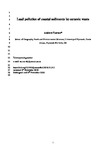Lead pollution of coastal sediments by ceramic waste
| dc.contributor.author | Turner, A | |
| dc.date.accessioned | 2019-01-21T13:14:07Z | |
| dc.date.available | 2019-01-21T13:14:07Z | |
| dc.date.issued | 2019-01-01 | |
| dc.identifier.issn | 0025-326X | |
| dc.identifier.issn | 1879-3363 | |
| dc.identifier.uri | http://hdl.handle.net/10026.1/13187 | |
| dc.description.abstract |
© 2018 Ceramic fragments and fractionated (<2 mm) sediment have been sampled from two beaches in southwest England, along with sediment from a control beach where ceramic waste was lacking. Analysis of the glazed ceramic surfaces by X-ray fluorescence (XRF) spectrometry returned concentrations of Pb up to 729,000 mg kg−1, while XRF analysis of sediment samples revealed high but heterogeneous concentrations of Pb at the two sites impacted by ceramic waste (median = 292 and 737 mg kg−1) compared with the control beach (median ~ 20 mg kg−1). These observations are attributed to the disposal of contemporary and historical ceramic products, and the subsequent attrition of material and contamination of local sediment. Extraction of a milled ceramic composite (Pb = 2780 mg kg−1) by 1 M HCl, revealed a high (34%) environmental mobility and availability of Pb; extraction in a solution of protein, however, suggested a low (0.1%) bioaccessibility to sediment-ingesting invertebrates. | |
| dc.format.extent | 171-176 | |
| dc.format.medium | Print-Electronic | |
| dc.language | en | |
| dc.language.iso | en | |
| dc.publisher | Elsevier | |
| dc.subject | Ceramic fragments | |
| dc.subject | Glaze | |
| dc.subject | Lead | |
| dc.subject | Sediments | |
| dc.subject | Contamination | |
| dc.title | Lead pollution of coastal sediments by ceramic waste | |
| dc.type | journal-article | |
| dc.type | Article | |
| plymouth.author-url | https://www.ncbi.nlm.nih.gov/pubmed/30660259 | |
| plymouth.volume | 138 | |
| plymouth.publication-status | Published | |
| plymouth.journal | Marine Pollution Bulletin | |
| dc.identifier.doi | 10.1016/j.marpolbul.2018.11.013 | |
| plymouth.organisational-group | /Plymouth | |
| plymouth.organisational-group | /Plymouth/Faculty of Science and Engineering | |
| plymouth.organisational-group | /Plymouth/Faculty of Science and Engineering/School of Geography, Earth and Environmental Sciences | |
| plymouth.organisational-group | /Plymouth/REF 2021 Researchers by UoA | |
| plymouth.organisational-group | /Plymouth/REF 2021 Researchers by UoA/UoA07 Earth Systems and Environmental Sciences | |
| plymouth.organisational-group | /Plymouth/Research Groups | |
| plymouth.organisational-group | /Plymouth/Research Groups/BEACh | |
| plymouth.organisational-group | /Plymouth/Research Groups/Marine Institute | |
| plymouth.organisational-group | /Plymouth/Users by role | |
| plymouth.organisational-group | /Plymouth/Users by role/Academics | |
| dc.publisher.place | England | |
| dcterms.dateAccepted | 2018-11-08 | |
| dc.rights.embargodate | 2019-11-23 | |
| dc.identifier.eissn | 1879-3363 | |
| dc.rights.embargoperiod | Not known | |
| rioxxterms.versionofrecord | 10.1016/j.marpolbul.2018.11.013 | |
| rioxxterms.licenseref.uri | http://www.rioxx.net/licenses/all-rights-reserved | |
| rioxxterms.licenseref.startdate | 2019-01-01 | |
| rioxxterms.type | Journal Article/Review |


